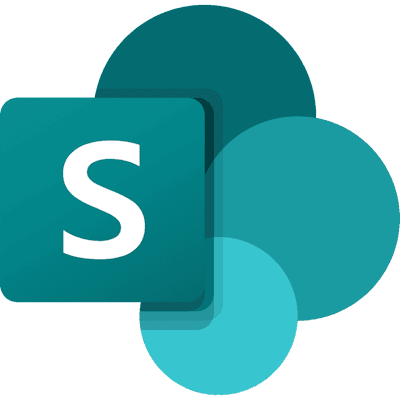Microsoft SharePoint
Achieve your AI goals with a secure, enterprise-grade content management and collaboration platform.

Overview
SharePoint is a powerful platform developed by Microsoft that enables businesses to create, manage, and share content and applications seamlessly. It serves as a solution for collaboration, allowing team members to work together efficiently, regardless of their physical location. With SharePoint, organizations can create intranet sites, which act as centralized hubs for company information, document management, and internal communication.
Seamlessly Integrate with Other Microsoft Tools
Unlock the full potential with SharePoint’s seamless integration across Microsoft tools like Teams, Outlook, and Office. SharePoint transforms the way you work by centralizing your documents, streamlining collaboration, and automating workflows—all in one secure platform.
Say goodbye to outdated files and messy email chains. With real-time collaborative editing, version control, and secure file sharing, everyone stays aligned with the latest information. Customizable workflows take repetitive tasks off your plate, so your team can focus on what truly matters.
Need to manage projects or track tasks? SharePoint keeps everyone on the same page with easy-to-use tools for task assignments, progress tracking, and deadline management. Its deep integration with Microsoft’s ecosystem ensures a smooth, productive experience, giving your business a competitive edge.
Whether you're running a lean startup or managing a growing enterprise, SharePoint scales with your business, adapting to meet your needs. Empower your team, streamline communication, and achieve your goals faster with SharePoint.
What is the Difference Between SharePoint and OneDrive?
While both SharePoint and OneDrive are part of Microsoft’s ecosystem and offer cloud storage solutions, they cater to different needs and use cases. OneDrive is designed primarily for personal storage and individual file sharing. It allows users to save their own files and access them from anywhere, making it ideal for individuals or small teams needing private, secure access to their work.
SharePoint, on the other hand, is a broader collaboration platform geared toward team and organization-wide use. It is ideal for managing shared resources, creating intranet sites, and enabling real-time collaboration on projects. SharePoint is specifically built to organize and centralize content for teams, facilitating better alignment and streamlined workflows. While OneDrive supports individual productivity, SharePoint enhances team and organizational efficiency by fostering collaboration and communication across departments.
History of SharePoint
SharePoint was introduced by Microsoft in 2001 as a part of Office XP. Initially named "SharePoint Portal Server," it was designed to facilitate document management and enterprise search capabilities. The platform quickly evolved, with SharePoint Portal Server 2003 and Windows SharePoint Services (WSS) widening its scope to include more collaboration features and integration with Microsoft Office.
The significant transformation of SharePoint came with the release of SharePoint 2007, which integrated web content management, business intelligence, and an expanded set of collaboration tools. This version marked the beginning of SharePoint's journey as a full-fledged intranet platform. Subsequent versions, such as SharePoint 2010 and SharePoint 2013, introduced advancements like social networking, improved workflows, and Ccloud-based services, expanding its footprint within both the private and public sectors.
SharePoint Online's introduction as a part of Office 365 in 2011 shifted the trajectory towards Cloud-based solutions, allowing organizations to leverage the power of SharePoint without the need for extensive on-premises infrastructure. With the release of SharePoint 2016 and SharePoint 2019, Microsoft continued to refine the platform, integrating modern design principles, enhanced security, and tighter integrations with other Microsoft services, including Azure and Microsoft 365.
Today, SharePoint remains a cornerstone of Microsoft's enterprise solutions, continually evolving to meet the dynamic needs of businesses worldwide. It provides a versatile platform that combines file storage, collaboration, process automation, and advanced search capabilities, fostering a more connected and productive workplace.
Top SharePoint Features
SharePoint offers a wide range of features designed to improve collaboration, content management, and overall productivity. Below are some of the top features that make SharePoint an essential tool for teams and organizations:
By leveraging these features, organizations can transform the way they manage resources, foster collaboration, and achieve their goals. SharePoint is built to meet the demands of modern workplaces, making it an indispensable tool for any team.
Challenges with SharePoint
Despite its extensive capabilities, adopting and managing SharePoint can present a range of challenges for organizations.
One significant challenge is implementation complexity. With its vast array of features, configuring SharePoint to meet specific business needs can be a daunting task, often requiring specialized knowledge and expertise to tailor the platform effectively.
User adoption is another common issue. Employees might resist transitioning to a new system or may struggle with understanding how to effectively utilize SharePoint's capabilities. This can result in underutilization of the platform and decreased return on investment. Continuous training and user support are essential to overcoming this hurdle.
Customization and scalability can also pose challenges. While SharePoint offers extensive customization options, overly complex customizations can lead to maintenance difficulties and upgrade issues. Additionally, as organizations grow and their needs evolve, scaling SharePoint to keep up with increased demands without compromising performance or stability can be problematic
Integration with existing systems is another area where organizations may encounter difficulties. Ensuring seamless interaction between SharePoint and other software applications within the enterprise ecosystem requires careful planning and technical solutions.
Lastly, security and compliance are critical areas that need careful attention. Protecting sensitive business data and ensuring compliance with regulatory standards requires security measures and vigilant oversight. SharePoint administrators must continuously monitor, update, and manage security settings to protect against vulnerabilities.
Addressing these challenges effectively often involves a combination of strategic planning, continuous education, and leveraging the expertise of SharePoint specialists to maximize the platform's potential.

Effective Implementation of SharePoint
SharePoint is not something you just turn on but could instead represent one of the biggest changes in how your company does business. Successful deployment of SharePoint requires comprehensive planning, discussion, and ownership. To ensure the platform is integrated effectively, it's crucial to engage in thorough strategizing to align SharePoint's capabilities with your organizational goals.
- Planning involves identifying your business needs, defining the scope of the project, and setting clear objectives. Understanding what you want to achieve with SharePoint will help in configuring it to meet your specific requirements.
- Discussion within your organization is essential to gather input from various stakeholders. This ensures that the needs of different departments are considered and that the solution supports cross-functional collaboration.
- Ownership of the platform should be clearly established. It is vital to designate a person or a team responsible for overseeing the implementation, maintenance, and governance of SharePoint. This ownership certifies that there is accountability and continuity in managing the platform.
- Training your employees on how to use SharePoint effectively is a cornerstone of successful implementation.
Moreover, maintaining a strong relationship with your developer and system manager is paramount. These roles are instrumental in customizing SharePoint, troubleshooting issues, and guaranteeing the system's performance. Regular communication and collaboration with technical experts will help in adapting the platform effectively to changing business needs and in optimizing its use.
In conclusion, embracing SharePoint is more than a technical endeavor; it requires a holistic approach involving strategic planning, inclusive discussions, committed ownership, and strong technical partnerships. This combined effort will enable your organization to harness the full potential of SharePoint and drive meaningful business transformation.
How Can Intrada Help?
Are you ready to unlock the full potential of Microsoft SharePoint and propel your business towards greater efficiency and innovation? Reach out to Intrada today to discuss how our tailored solutions can transform your organization. Whether you're looking to enhance productivity, streamline workflows, or improve data security, our expert team is here to support you every step of the way.
Contact us now to schedule a consultation and discover how Intrada's dedication to excellence can drive your success. Let's collaborate and innovate together for a brighter, more productive future.


